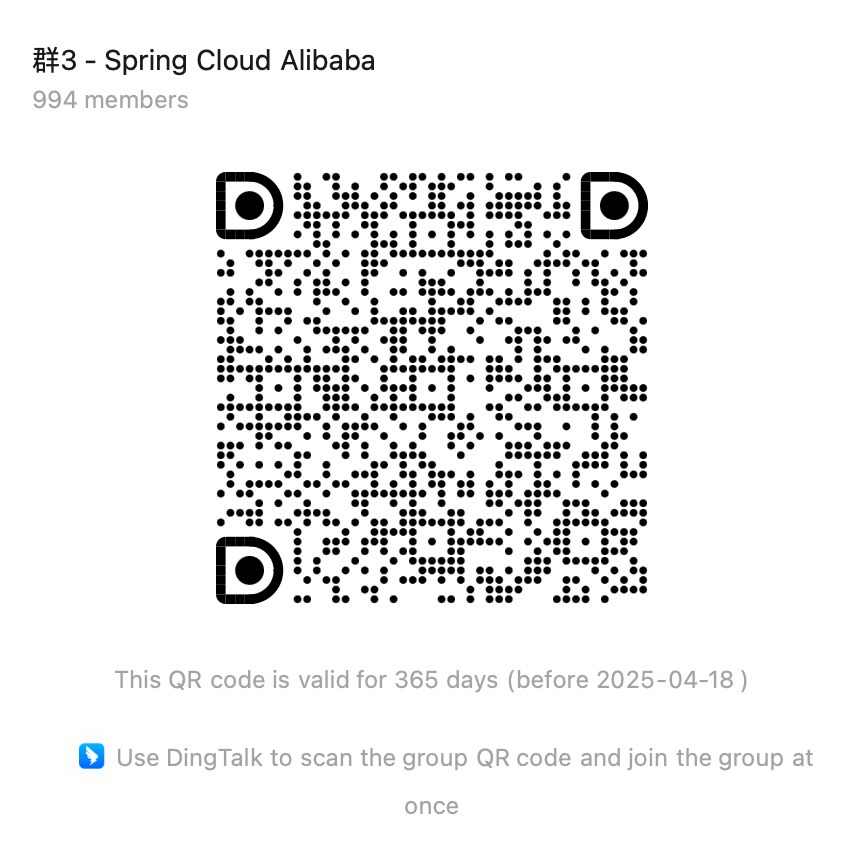Spring AI 源码解析:Tool Calling链路调用流程及示例
发布时间 2025-04-01
Tool工具允许模型与一组API或工具进行交互,增强模型功能,主要用于:
- 信息检索:从外部数据源检索信息,如数据库、Web服务、文件系统或Web搜索引擎等
- 采取行动:可用于在软件系统中执行特定操作,如发送电子邮件、在数据库中创建新记录、触发工作流等
注:
- 本版源码解析取自Spring-ai(20250321)仓库最新代码(暂未发版),目前最新的1.0.0.-M6有部分类和方法将过期,故不在此讨论范畴中
本文实践代码可见spingr-ai-alibaba-examples项目下的spring-ai-alibaba-tool-calling-examples
理论部分

- 在聊天请求中包含工具的定义,包括工具名称、描述、输入模式
- 当AI模型决定调用一个工具时,会发送一个响应,包含工具名称和输入参数(大模型提取文本根据输入模式转化而得)
- 应用程序将使用工具名称并使用提供的输入参数
- 工具计算结果后将结果返回给应用程序
- 应用程序再将结果发送给模型
- 模型添加工具结果作为附加的上下文信息生成最终响应
工具调用链路(核心)
下图以ChatClient调用tools(String… toolNames)方法全链路流程展示

public class DefaultChatClient implements ChatClient { @Override public ChatClientRequestSpec tools(String... toolNames) { Assert.notNull(toolNames, "toolNames cannot be null"); Assert.noNullElements(toolNames, "toolNames cannot contain null elements"); this.functionNames.addAll(List.of(toolNames)); return this; }
@Override public ChatClientRequestSpec tools(FunctionCallback... toolCallbacks) { Assert.notNull(toolCallbacks, "toolCallbacks cannot be null"); Assert.noNullElements(toolCallbacks, "toolCallbacks cannot contain null elements"); this.functionCallbacks.addAll(List.of(toolCallbacks)); return this; }
@Override public ChatClientRequestSpec tools(List<ToolCallback> toolCallbacks) { Assert.notNull(toolCallbacks, "toolCallbacks cannot be null"); Assert.noNullElements(toolCallbacks, "toolCallbacks cannot contain null elements"); this.functionCallbacks.addAll(toolCallbacks); return this; }
@Override public ChatClientRequestSpec tools(Object... toolObjects) { Assert.notNull(toolObjects, "toolObjects cannot be null"); Assert.noNullElements(toolObjects, "toolObjects cannot contain null elements"); this.functionCallbacks.addAll(Arrays.asList(ToolCallbacks.from(toolObjects))); return this; }
@Override public ChatClientRequestSpec tools(ToolCallbackProvider... toolCallbackProviders) { Assert.notNull(toolCallbackProviders, "toolCallbackProviders cannot be null"); Assert.noNullElements(toolCallbackProviders, "toolCallbackProviders cannot contain null elements"); for (ToolCallbackProvider toolCallbackProvider : toolCallbackProviders) { this.functionCallbacks.addAll(List.of(toolCallbackProvider.getToolCallbacks())); } return this; }
}Tool(工具注解)
@Target({ ElementType.METHOD, ElementType.ANNOTATION_TYPE })@Retention(RetentionPolicy.RUNTIME)@Documentedpublic @interface Tool {
/** * The name of the tool. If not provided, the method name will be used. */ String name() default "";
/** * The description of the tool. If not provided, the method name will be used. */ String description() default "";
/** * Whether the tool result should be returned directly or passed back to the model. */ boolean returnDirect() default false;
/** * The class to use to convert the tool call result to a String. */ Class<? extends ToolCallResultConverter> resultConverter() default DefaultToolCallResultConverter.class;
}ToolDefinition(工具定义)
public interface ToolDefinition { // 工具的名称,提供给一个模型时要求唯一标识 String name(); // 工具描述 String description(); // 工具的输入模式 String inputSchema();
static DefaultToolDefinition.Builder builder() { return DefaultToolDefinition.builder(); } // 从方法中提取出工具的名称、描述、输入模式 static DefaultToolDefinition.Builder builder(Method method) { Assert.notNull(method, "method cannot be null"); return DefaultToolDefinition.builder() .name(ToolUtils.getToolName(method)) .description(ToolUtils.getToolDescription(method)) .inputSchema(JsonSchemaGenerator.generateForMethodInput(method)); }
static ToolDefinition from(Method method) { return ToolDefinition.builder(method).build(); }
}DefaultToolDefinition
public record DefaultToolDefinition(String name, String description, String inputSchema) implements ToolDefinition {
public DefaultToolDefinition { Assert.hasText(name, "name cannot be null or empty"); Assert.hasText(description, "description cannot be null or empty"); Assert.hasText(inputSchema, "inputSchema cannot be null or empty"); }
public static Builder builder() { return new Builder(); }
public static class Builder {
private String name;
private String description;
private String inputSchema;
private Builder() { }
public Builder name(String name) { this.name = name; return this; }
public Builder description(String description) { this.description = description; return this; }
public Builder inputSchema(String inputSchema) { this.inputSchema = inputSchema; return this; }
public ToolDefinition build() { if (!StringUtils.hasText(description)) { description = ToolUtils.getToolDescriptionFromName(name); } return new DefaultToolDefinition(name, description, inputSchema); }
}
}ToolMetadata(工具元数据)
现阶段只用于控制直接将工具结果返回,不再走模型响应
public interface ToolMetadata {
default boolean returnDirect() { return false; }
static DefaultToolMetadata.Builder builder() { return DefaultToolMetadata.builder(); }
static ToolMetadata from(Method method) { Assert.notNull(method, "method cannot be null"); return DefaultToolMetadata.builder().returnDirect(ToolUtils.getToolReturnDirect(method)).build(); }
}DefaultToolMetadata
public record DefaultToolMetadata(boolean returnDirect) implements ToolMetadata {
public static Builder builder() { return new Builder(); }
public static class Builder {
private boolean returnDirect = false;
private Builder() { }
public Builder returnDirect(boolean returnDirect) { this.returnDirect = returnDirect; return this; }
public ToolMetadata build() { return new DefaultToolMetadata(returnDirect); }
}
}ToolCallback(工具回调)
public interface ToolCallback{
// AI模型用来确定何时以及如何调用工具的定义 ToolDefinition getToolDefinition();
// 元数据提供了额外的信息怎么操作工具 default ToolMetadata getToolMetadata() { return ToolMetadata.builder().build(); }
// toolInput为工具的输入,最终返回结果工具的结果 String call(String toolInput);
// toolInput为工具的输入,tooContext为工具的上下文信息 default String call(String toolInput, @Nullable ToolContext tooContext) { if (tooContext != null && !tooContext.getContext().isEmpty()) { throw new UnsupportedOperationException("Tool context is not supported!"); } return call(toolInput); }
}MethodToolCallback
核心方法主要关注call
-
将模型处理后的字符串文本,转化为对应的输入模式
-
Map<String, Object> toolArguments = extractToolArguments(toolInput);Object[] methodArguments = buildMethodArguments(toolArguments, toolContext);
-
-
调用工具的方法+输入参数,得到工具的输出结果
-
Object result = callMethod(methodArguments);
-
-
将工具的输出结果的类型进行转化
-
Type returnType = toolMethod.getGenericReturnType();return toolCallResultConverter.convert(result, returnType);
-
public class MethodToolCallback implements ToolCallback {
private static final Logger logger = LoggerFactory.getLogger(MethodToolCallback.class);
private static final ToolCallResultConverter DEFAULT_RESULT_CONVERTER = new DefaultToolCallResultConverter();
private static final ToolMetadata DEFAULT_TOOL_METADATA = ToolMetadata.builder().build();
private final ToolDefinition toolDefinition;
private final ToolMetadata toolMetadata;
private final Method toolMethod;
@Nullable private final Object toolObject;
private final ToolCallResultConverter toolCallResultConverter;
public MethodToolCallback(ToolDefinition toolDefinition, @Nullable ToolMetadata toolMetadata, Method toolMethod, @Nullable Object toolObject, @Nullable ToolCallResultConverter toolCallResultConverter) { Assert.notNull(toolDefinition, "toolDefinition cannot be null"); Assert.notNull(toolMethod, "toolMethod cannot be null"); Assert.isTrue(Modifier.isStatic(toolMethod.getModifiers()) || toolObject != null, "toolObject cannot be null for non-static methods"); this.toolDefinition = toolDefinition; this.toolMetadata = toolMetadata != null ? toolMetadata : DEFAULT_TOOL_METADATA; this.toolMethod = toolMethod; this.toolObject = toolObject; this.toolCallResultConverter = toolCallResultConverter != null ? toolCallResultConverter : DEFAULT_RESULT_CONVERTER; }
@Override public ToolDefinition getToolDefinition() { return toolDefinition; }
@Override public ToolMetadata getToolMetadata() { return toolMetadata; }
@Override public String call(String toolInput) { return call(toolInput, null); }
@Override public String call(String toolInput, @Nullable ToolContext toolContext) { Assert.hasText(toolInput, "toolInput cannot be null or empty");
logger.debug("Starting execution of tool: {}", toolDefinition.name());
validateToolContextSupport(toolContext);
Map<String, Object> toolArguments = extractToolArguments(toolInput);
Object[] methodArguments = buildMethodArguments(toolArguments, toolContext);
Object result = callMethod(methodArguments);
logger.debug("Successful execution of tool: {}", toolDefinition.name());
Type returnType = toolMethod.getGenericReturnType();
return toolCallResultConverter.convert(result, returnType); }
private void validateToolContextSupport(@Nullable ToolContext toolContext) { var isNonEmptyToolContextProvided = toolContext != null && !CollectionUtils.isEmpty(toolContext.getContext()); var isToolContextAcceptedByMethod = Stream.of(toolMethod.getParameterTypes()) .anyMatch(type -> ClassUtils.isAssignable(type, ToolContext.class)); if (isToolContextAcceptedByMethod && !isNonEmptyToolContextProvided) { throw new IllegalArgumentException("ToolContext is required by the method as an argument"); } }
private Map<String, Object> extractToolArguments(String toolInput) { return JsonParser.fromJson(toolInput, new TypeReference<>() { }); }
// Based on the implementation in MethodInvokingFunctionCallback. private Object[] buildMethodArguments(Map<String, Object> toolInputArguments, @Nullable ToolContext toolContext) { return Stream.of(toolMethod.getParameters()).map(parameter -> { if (parameter.getType().isAssignableFrom(ToolContext.class)) { return toolContext; } Object rawArgument = toolInputArguments.get(parameter.getName()); return buildTypedArgument(rawArgument, parameter.getType()); }).toArray(); }
@Nullable private Object buildTypedArgument(@Nullable Object value, Class<?> type) { if (value == null) { return null; } return JsonParser.toTypedObject(value, type); }
@Nullable private Object callMethod(Object[] methodArguments) { if (isObjectNotPublic() || isMethodNotPublic()) { toolMethod.setAccessible(true); }
Object result; try { result = toolMethod.invoke(toolObject, methodArguments); } catch (IllegalAccessException ex) { throw new IllegalStateException("Could not access method: " + ex.getMessage(), ex); } catch (InvocationTargetException ex) { throw new ToolExecutionException(toolDefinition, ex.getCause()); } return result; }
private boolean isObjectNotPublic() { return toolObject != null && !Modifier.isPublic(toolObject.getClass().getModifiers()); }
private boolean isMethodNotPublic() { return !Modifier.isPublic(toolMethod.getModifiers()); }
@Override public String toString() { return "MethodToolCallback{" + "toolDefinition=" + toolDefinition + ", toolMetadata=" + toolMetadata + '}'; }
public static Builder builder() { return new Builder(); }
public static class Builder {
private ToolDefinition toolDefinition;
private ToolMetadata toolMetadata;
private Method toolMethod;
private Object toolObject;
private ToolCallResultConverter toolCallResultConverter;
private Builder() { }
public Builder toolDefinition(ToolDefinition toolDefinition) { this.toolDefinition = toolDefinition; return this; }
public Builder toolMetadata(ToolMetadata toolMetadata) { this.toolMetadata = toolMetadata; return this; }
public Builder toolMethod(Method toolMethod) { this.toolMethod = toolMethod; return this; }
public Builder toolObject(Object toolObject) { this.toolObject = toolObject; return this; }
public Builder toolCallResultConverter(ToolCallResultConverter toolCallResultConverter) { this.toolCallResultConverter = toolCallResultConverter; return this; }
public MethodToolCallback build() { return new MethodToolCallback(toolDefinition, toolMetadata, toolMethod, toolObject, toolCallResultConverter); }
}
}FunctionToolCallback
核心方法主要关注call
- 模型提取的toolInput为json字符串,先转为定义的Request类型
I request = JsonParser.fromJson(toolInput, toolInputType);- 工具调用,返回对应的工具结果
O response = toolFunction.apply(request, toolContext);public class FunctionToolCallback<I, O> implements ToolCallback {
private static final Logger logger = LoggerFactory.getLogger(FunctionToolCallback.class);
private static final ToolCallResultConverter DEFAULT_RESULT_CONVERTER = new DefaultToolCallResultConverter();
private static final ToolMetadata DEFAULT_TOOL_METADATA = ToolMetadata.builder().build();
private final ToolDefinition toolDefinition;
private final ToolMetadata toolMetadata;
private final Type toolInputType;
private final BiFunction<I, ToolContext, O> toolFunction;
private final ToolCallResultConverter toolCallResultConverter;
public FunctionToolCallback(ToolDefinition toolDefinition, @Nullable ToolMetadata toolMetadata, Type toolInputType, BiFunction<I, ToolContext, O> toolFunction, @Nullable ToolCallResultConverter toolCallResultConverter) { Assert.notNull(toolDefinition, "toolDefinition cannot be null"); Assert.notNull(toolInputType, "toolInputType cannot be null"); Assert.notNull(toolFunction, "toolFunction cannot be null"); this.toolDefinition = toolDefinition; this.toolMetadata = toolMetadata != null ? toolMetadata : DEFAULT_TOOL_METADATA; this.toolFunction = toolFunction; this.toolInputType = toolInputType; this.toolCallResultConverter = toolCallResultConverter != null ? toolCallResultConverter : DEFAULT_RESULT_CONVERTER; }
@Override public ToolDefinition getToolDefinition() { return toolDefinition; }
@Override public ToolMetadata getToolMetadata() { return toolMetadata; }
@Override public String call(String toolInput) { return call(toolInput, null); }
@Override public String call(String toolInput, @Nullable ToolContext toolContext) { Assert.hasText(toolInput, "toolInput cannot be null or empty");
logger.debug("Starting execution of tool: {}", toolDefinition.name());
I request = JsonParser.fromJson(toolInput, toolInputType); O response = toolFunction.apply(request, toolContext);
logger.debug("Successful execution of tool: {}", toolDefinition.name());
return toolCallResultConverter.convert(response, null); }
@Override public String toString() { return "FunctionToolCallback{" + "toolDefinition=" + toolDefinition + ", toolMetadata=" + toolMetadata + '}'; }
public static <I, O> Builder<I, O> builder(String name, BiFunction<I, ToolContext, O> function) { return new Builder<>(name, function); }
public static <I, O> Builder<I, O> builder(String name, Function<I, O> function) { Assert.notNull(function, "function cannot be null"); return new Builder<>(name, (request, context) -> function.apply(request)); }
public static <O> Builder<Void, O> builder(String name, Supplier<O> supplier) { Assert.notNull(supplier, "supplier cannot be null"); Function<Void, O> function = input -> supplier.get(); return builder(name, function).inputType(Void.class); }
public static <I> Builder<I, Void> builder(String name, Consumer<I> consumer) { Assert.notNull(consumer, "consumer cannot be null"); Function<I, Void> function = (I input) -> { consumer.accept(input); return null; }; return builder(name, function); }
public static class Builder<I, O> {
private String name;
private String description;
private String inputSchema;
private Type inputType;
private ToolMetadata toolMetadata;
private BiFunction<I, ToolContext, O> toolFunction;
private ToolCallResultConverter toolCallResultConverter;
private Builder(String name, BiFunction<I, ToolContext, O> toolFunction) { Assert.hasText(name, "name cannot be null or empty"); Assert.notNull(toolFunction, "toolFunction cannot be null"); this.name = name; this.toolFunction = toolFunction; }
public Builder<I, O> description(String description) { this.description = description; return this; }
public Builder<I, O> inputSchema(String inputSchema) { this.inputSchema = inputSchema; return this; }
public Builder<I, O> inputType(Type inputType) { this.inputType = inputType; return this; }
public Builder<I, O> inputType(ParameterizedTypeReference<?> inputType) { Assert.notNull(inputType, "inputType cannot be null"); this.inputType = inputType.getType(); return this; }
public Builder<I, O> toolMetadata(ToolMetadata toolMetadata) { this.toolMetadata = toolMetadata; return this; }
public Builder<I, O> toolCallResultConverter(ToolCallResultConverter toolCallResultConverter) { this.toolCallResultConverter = toolCallResultConverter; return this; }
public FunctionToolCallback<I, O> build() { Assert.notNull(inputType, "inputType cannot be null"); var toolDefinition = ToolDefinition.builder() .name(name) .description( StringUtils.hasText(description) ? description : ToolUtils.getToolDescriptionFromName(name)) .inputSchema( StringUtils.hasText(inputSchema) ? inputSchema : JsonSchemaGenerator.generateForType(inputType)) .build(); return new FunctionToolCallback<>(toolDefinition, toolMetadata, inputType, toolFunction, toolCallResultConverter); }
}
}ToolCallbackProvider(工具回调实例提供)
主要用于集中管理和提供工具回调
- getToolCallbacks:获得工具回调数组
public interface ToolCallbackProvider {
ToolCallback[] getToolCallbacks();
static ToolCallbackProvider from(List<? extends FunctionCallback> toolCallbacks) { return new StaticToolCallbackProvider(toolCallbacks); }
static ToolCallbackProvider from(FunctionCallback... toolCallbacks) { return new StaticToolCallbackProvider(toolCallbacks); }
}MethodToolCallbackProvider
获取MethodToolCallback实例
public class MethodToolCallbackProvider implements ToolCallbackProvider {
private static final Logger logger = LoggerFactory.getLogger(MethodToolCallbackProvider.class);
private final List<Object> toolObjects;
private MethodToolCallbackProvider(List<Object> toolObjects) { Assert.notNull(toolObjects, "toolObjects cannot be null"); Assert.noNullElements(toolObjects, "toolObjects cannot contain null elements"); this.toolObjects = toolObjects; }
@Override public ToolCallback[] getToolCallbacks() { var toolCallbacks = toolObjects.stream() .map(toolObject -> Stream .of(ReflectionUtils.getDeclaredMethods( AopUtils.isAopProxy(toolObject) ? AopUtils.getTargetClass(toolObject) : toolObject.getClass())) .filter(toolMethod -> toolMethod.isAnnotationPresent(Tool.class)) .filter(toolMethod -> !isFunctionalType(toolMethod)) .map(toolMethod -> MethodToolCallback.builder() .toolDefinition(ToolDefinition.from(toolMethod)) .toolMetadata(ToolMetadata.from(toolMethod)) .toolMethod(toolMethod) .toolObject(toolObject) .toolCallResultConverter(ToolUtils.getToolCallResultConverter(toolMethod)) .build()) .toArray(ToolCallback[]::new)) .flatMap(Stream::of) .toArray(ToolCallback[]::new);
validateToolCallbacks(toolCallbacks);
return toolCallbacks; }
private boolean isFunctionalType(Method toolMethod) { var isFunction = ClassUtils.isAssignable(toolMethod.getReturnType(), Function.class) || ClassUtils.isAssignable(toolMethod.getReturnType(), Supplier.class) || ClassUtils.isAssignable(toolMethod.getReturnType(), Consumer.class);
if (isFunction) { logger.warn("Method {} is annotated with @Tool but returns a functional type. " + "This is not supported and the method will be ignored.", toolMethod.getName()); }
return isFunction; }
private void validateToolCallbacks(ToolCallback[] toolCallbacks) { List<String> duplicateToolNames = ToolUtils.getDuplicateToolNames(toolCallbacks); if (!duplicateToolNames.isEmpty()) { throw new IllegalStateException("Multiple tools with the same name (%s) found in sources: %s".formatted( String.join(", ", duplicateToolNames), toolObjects.stream().map(o -> o.getClass().getName()).collect(Collectors.joining(", ")))); } }
public static Builder builder() { return new Builder(); }
public static class Builder {
private List<Object> toolObjects;
private Builder() { }
public Builder toolObjects(Object... toolObjects) { Assert.notNull(toolObjects, "toolObjects cannot be null"); this.toolObjects = Arrays.asList(toolObjects); return this; }
public MethodToolCallbackProvider build() { return new MethodToolCallbackProvider(toolObjects); }
}
}StaticToolCallbackProvider
提供FunctionToolCallback,但目测还没有实现该功能
public class StaticToolCallbackProvider implements ToolCallbackProvider {
private final FunctionCallback[] toolCallbacks;
public StaticToolCallbackProvider(FunctionCallback... toolCallbacks) { Assert.notNull(toolCallbacks, "ToolCallbacks must not be null"); this.toolCallbacks = toolCallbacks; }
public StaticToolCallbackProvider(List<? extends FunctionCallback> toolCallbacks) { Assert.noNullElements(toolCallbacks, "toolCallbacks cannot contain null elements"); this.toolCallbacks = toolCallbacks.toArray(new FunctionCallback[0]); }
@Override public FunctionCallback[] getToolCallbacks() { return this.toolCallbacks; }
}ToolCallingManager(工具回调管理器)
public interface ToolCallingManager {
// 从配置中提取工具的定义,确保模型能正确识别和使用工具 List<ToolDefinition> resolveToolDefinitions(ToolCallingChatOptions chatOptions);
// 根据模型的响应,执行响应的工具调用,并返回执行结果 ToolExecutionResult executeToolCalls(Prompt prompt, ChatResponse chatResponse);
// 构建工具调用管理器 static DefaultToolCallingManager.Builder builder() { return DefaultToolCallingManager.builder(); }
}DefaultToolCallingManager
核心功能如下
- 解析工具定义(resolveToolDefinitions):从ToolCallingChatOptions中解析出工具定义,确保模型能正确识别和使用工具
- 执行工具调用(executeToolCalls):根据模型响应,执行相应的工具调用,并返回工具的执行结果
- 构建工具上下文(buildToolContext):为工具调用提供上下文信息,历史的Message记录
- 管理工具回调:通过 ToolCallbackResolver 解析工具回调,支持动态工具调用
public class DefaultToolCallingManager implements ToolCallingManager {
@Override public List<ToolDefinition> resolveToolDefinitions(ToolCallingChatOptions chatOptions) { Assert.notNull(chatOptions, "chatOptions cannot be null");
List<FunctionCallback> toolCallbacks = new ArrayList<>(chatOptions.getToolCallbacks()); for (String toolName : chatOptions.getToolNames()) { // Skip the tool if it is already present in the request toolCallbacks. // That might happen if a tool is defined in the options // both as a ToolCallback and as a tool name. if (chatOptions.getToolCallbacks().stream().anyMatch(tool -> tool.getName().equals(toolName))) { continue; } FunctionCallback toolCallback = toolCallbackResolver.resolve(toolName); if (toolCallback == null) { throw new IllegalStateException("No ToolCallback found for tool name: " + toolName); } toolCallbacks.add(toolCallback); }
return toolCallbacks.stream().map(functionCallback -> { if (functionCallback instanceof ToolCallback toolCallback) { return toolCallback.getToolDefinition(); } else { return ToolDefinition.builder() .name(functionCallback.getName()) .description(functionCallback.getDescription()) .inputSchema(functionCallback.getInputTypeSchema()) .build(); } }).toList(); }
@Override public ToolExecutionResult executeToolCalls(Prompt prompt, ChatResponse chatResponse) { Assert.notNull(prompt, "prompt cannot be null"); Assert.notNull(chatResponse, "chatResponse cannot be null");
Optional<Generation> toolCallGeneration = chatResponse.getResults() .stream() .filter(g -> !CollectionUtils.isEmpty(g.getOutput().getToolCalls())) .findFirst();
if (toolCallGeneration.isEmpty()) { throw new IllegalStateException("No tool call requested by the chat model"); }
AssistantMessage assistantMessage = toolCallGeneration.get().getOutput();
ToolContext toolContext = buildToolContext(prompt, assistantMessage);
InternalToolExecutionResult internalToolExecutionResult = executeToolCall(prompt, assistantMessage, toolContext);
List<Message> conversationHistory = buildConversationHistoryAfterToolExecution(prompt.getInstructions(), assistantMessage, internalToolExecutionResult.toolResponseMessage());
return ToolExecutionResult.builder() .conversationHistory(conversationHistory) .returnDirect(internalToolExecutionResult.returnDirect()) .build(); }
}ToolCallResultConverter(工具结果转换器)
@FunctionalInterfacepublic interface ToolCallResultConverter {
// result:工具结果,returnType:返回类型 String convert(@Nullable Object result, @Nullable Type returnType);
}DefaultToolCallResultConverter
ToolCallResultConverter接口类暂时的唯一实现,转为Json化的字符串
public final class DefaultToolCallResultConverter implements ToolCallResultConverter {
private static final Logger logger = LoggerFactory.getLogger(DefaultToolCallResultConverter.class);
@Override public String convert(@Nullable Object result, @Nullable Type returnType) { if (returnType == Void.TYPE) { logger.debug("The tool has no return type. Converting to conventional response."); return "Done"; } else { logger.debug("Converting tool result to JSON."); return JsonParser.toJson(result); } }
}ToolContext(工具上下文)
被构建于工具回调管理器
作用:
- 用于封装工具执行的上下文信息,确保上下文不可变,从而保证线程安全
- 通过getContext方法获取整个上下文,通过getToolCallHistory方法获取Message的历史记录
public class ToolContext {
public static final String TOOL_CALL_HISTORY = "TOOL_CALL_HISTORY";
private final Map<String, Object> context;
public ToolContext(Map<String, Object> context) { this.context = Collections.unmodifiableMap(context); }
public Map<String, Object> getContext() { return this.context; }
@SuppressWarnings("unchecked") public List<Message> getToolCallHistory() { return (List<Message>) this.context.get(TOOL_CALL_HISTORY); }
}ToolUtils(工具常见方法封装)
从方法上提取名称,主要根据方法上是否有Tool注解,若无则统一设置为方法名
- getToolName:获取工具名称
- getToolDescriptionFromName:根据工具名称生成工具的描述
- getToolDescription:获取工具描述
- getToolReturnDirect:判断工具是否直接返回结果
- getToolCallResultConverter:获取工具的结果转换器
- getDuplicateToolNames:检查工具回调列表中是否有重复的工具名称
public final class ToolUtils {
private ToolUtils() { }
public static String getToolName(Method method) { Assert.notNull(method, "method cannot be null"); var tool = method.getAnnotation(Tool.class); if (tool == null) { return method.getName(); } return StringUtils.hasText(tool.name()) ? tool.name() : method.getName(); }
public static String getToolDescriptionFromName(String toolName) { Assert.hasText(toolName, "toolName cannot be null or empty"); return ParsingUtils.reConcatenateCamelCase(toolName, " "); }
public static String getToolDescription(Method method) { Assert.notNull(method, "method cannot be null"); var tool = method.getAnnotation(Tool.class); if (tool == null) { return ParsingUtils.reConcatenateCamelCase(method.getName(), " "); } return StringUtils.hasText(tool.description()) ? tool.description() : method.getName(); }
public static boolean getToolReturnDirect(Method method) { Assert.notNull(method, "method cannot be null"); var tool = method.getAnnotation(Tool.class); return tool != null && tool.returnDirect(); }
public static ToolCallResultConverter getToolCallResultConverter(Method method) { Assert.notNull(method, "method cannot be null"); var tool = method.getAnnotation(Tool.class); if (tool == null) { return new DefaultToolCallResultConverter(); } var type = tool.resultConverter(); try { return type.getDeclaredConstructor().newInstance(); } catch (Exception e) { throw new IllegalArgumentException("Failed to instantiate ToolCallResultConverter: " + type, e); } }
public static List<String> getDuplicateToolNames(List<FunctionCallback> toolCallbacks) { Assert.notNull(toolCallbacks, "toolCallbacks cannot be null"); return toolCallbacks.stream() .collect(Collectors.groupingBy(FunctionCallback::getName, Collectors.counting())) .entrySet() .stream() .filter(entry -> entry.getValue() > 1) .map(Map.Entry::getKey) .collect(Collectors.toList()); }
public static List<String> getDuplicateToolNames(FunctionCallback... toolCallbacks) { Assert.notNull(toolCallbacks, "toolCallbacks cannot be null"); return getDuplicateToolNames(Arrays.asList(toolCallbacks)); }
}tool工具实战(FunctionToolCallback && MethodToolCallBack版)
application.yml
server: port: 8083
spring: application: name: Tool-Calling
ai: dashscope: api-key: ${DASHSCOPE_API_KEY}
toolcalling: baidutranslate: enabled: true app-id : ${BAIDU_TRANSLATE_APP_ID} secret-key: ${BAIDU_TRANSLATE_SECRET_KEY}
time: enabled: true
weather: enabled: true api-key: ${WEATHER_API_KEY}百度翻译API接入文档:https://api.fanyi.baidu.com/product/113
天气预测API接入文档:https://www.weatherapi.com/docs/
当前时间
TimeAutoConfiguration
import org.springframework.boot.autoconfigure.condition.ConditionalOnClass;import org.springframework.boot.autoconfigure.condition.ConditionalOnMissingBean;import org.springframework.boot.autoconfigure.condition.ConditionalOnProperty;import org.springframework.context.annotation.Bean;import org.springframework.context.annotation.Configuration;import org.springframework.context.annotation.Description;
@Configuration@ConditionalOnClass({GetCurrentTimeByTimeZoneIdService.class})@ConditionalOnProperty(prefix = "spring.ai.toolcalling.time", name = "enabled", havingValue = "true")public class TimeAutoConfiguration {
@Bean(name = "getCityTimeFunction") @ConditionalOnMissingBean @Description("Get the time of a specified city.") public GetCurrentTimeByTimeZoneIdService getCityTimeFunction() { return new GetCurrentTimeByTimeZoneIdService(); }
}@Configuration:定义为配置类@ConditionalOnClass({GetCurrentTimeByTimeZoneIdService.class}):只有当类路径中存在GetCurrentTimeByTimeZoneIdService类才会加载该配置类@ConditionalOnProperty(prefix = "spring.ai.toolcalling.time", name = "enabled", havingValue = "true"):只有当配置文件处spring.ai.toolcalling.time.enabled值为true时才会加载该配置类@Bean(name = "getCityTimeFunction"):定义该Bean名称为getCityTimeFunction,并注册到Spring容器中@ConditionalOnMissingBean:只有当Spring容器中不存在GetCurrentTimeByTimeZoneIdService类型的Bean时,才会创建该Bean
GetCurrentTimeByTimeZoneIdService
import com.fasterxml.jackson.annotation.JsonClassDescription;import com.fasterxml.jackson.annotation.JsonInclude;import com.fasterxml.jackson.annotation.JsonProperty;import com.fasterxml.jackson.annotation.JsonPropertyDescription;import org.slf4j.Logger;import org.slf4j.LoggerFactory;
import java.util.function.Function;
public class GetCurrentTimeByTimeZoneIdService implements Function<GetCurrentTimeByTimeZoneIdService.Request, GetCurrentTimeByTimeZoneIdService.Response> {
private static final Logger logger = LoggerFactory.getLogger(GetCurrentTimeByTimeZoneIdService.class);
@Override public GetCurrentTimeByTimeZoneIdService.Response apply(GetCurrentTimeByTimeZoneIdService.Request request) { String timeZoneId = request.timeZoneId; logger.info("The current time zone is {}", timeZoneId); return new Response(String.format("The current time zone is %s and the current time is " + "%s", timeZoneId, ZoneUtils.getTimeByZoneId(timeZoneId))); }
@JsonInclude(JsonInclude.Include.NON_NULL) @JsonClassDescription("Get the current time based on time zone id") public record Request(@JsonProperty(required = true, value = "timeZoneId") @JsonPropertyDescription("Time " + "zone id, such as Asia/Shanghai") String timeZoneId) { }
@JsonClassDescription("Current time in that time zone") public record Response(@JsonPropertyDescription("A description containing the current time zone and the current time in that time zone") String description) { }
}- 实现Function接口,重写apply方法,确保输入为Request、输出为Response
- Request类为记录类,需要添加方法描述(JsonClassDescription) + 参数描述(JsonProperty),主要用于让模型提取出对应的输入参数timeZoneId
ZoneUtils
import java.time.ZoneId;import java.time.ZonedDateTime;import java.time.format.DateTimeFormatter;
public class ZoneUtils {
public static String getTimeByZoneId(String zoneId) {
// Get the time zone using ZoneId ZoneId zid = ZoneId.of(zoneId);
// Get the current time in this time zone ZonedDateTime zonedDateTime = ZonedDateTime.now(zid);
// Defining a formatter DateTimeFormatter formatter = DateTimeFormatter.ofPattern("yyyy-MM-dd HH:mm:ss z");
// Format ZonedDateTime as a string String formattedDateTime = zonedDateTime.format(formatter);
return formattedDateTime; }
}时区工具类,用来获取zoneId时区的当前时间
TimeTools(单独实现MethodToolCallback版)
import org.slf4j.Logger;import org.slf4j.LoggerFactory;import org.springframework.ai.tool.annotation.Tool;import org.springframework.ai.tool.annotation.ToolParam;
public class TimeTools { private static final Logger logger = LoggerFactory.getLogger(TimeTools.class);
@Tool(description = "Get the time of a specified city.") public String getCityTimeMethod(@ToolParam(description = "Time zone id, such as Asia/Shanghai") String timeZoneId) { logger.info("The current time zone is {}", timeZoneId); return String.format("The current time zone is %s and the current time is " + "%s", timeZoneId, ZoneUtils.getTimeByZoneId(timeZoneId)); }}TimeController
import com.yingzi.toolCalling.component.time.TimeTools;import org.springframework.ai.chat.client.ChatClient;import org.springframework.web.bind.annotation.GetMapping;import org.springframework.web.bind.annotation.RequestMapping;import org.springframework.web.bind.annotation.RequestParam;import org.springframework.web.bind.annotation.RestController;
@RestController@RequestMapping("/time")public class TimeController {
private final ChatClient dashScopeChatClient;
public TimeController(ChatClient.Builder chatClientBuilder) { this.dashScopeChatClient = chatClientBuilder.build(); }
/** * 无工具版 */ @GetMapping("/chat") public String simpleChat(@RequestParam(value = "query", defaultValue = "请告诉我现在北京时间几点了") String query) { return dashScopeChatClient.prompt(query).call().content(); }
/** * 调用工具版 - function */ @GetMapping("/chat-tool-function") public String chatTranslateFunction(@RequestParam(value = "query", defaultValue = "请告诉我现在北京时间几点了") String query) { return dashScopeChatClient.prompt(query).tools("getCityTimeFunction").call().content(); }
/** * 调用工具版 - method */ @GetMapping("/chat-tool-method") public String chatTranslateMethod(@RequestParam(value = "query", defaultValue = "请告诉我现在北京时间几点了") String query) { return dashScopeChatClient.prompt(query).tools(new TimeTools()).call().content(); }
}提供无工具版、工具版接口
效果展示
无工具版

工具版 - function
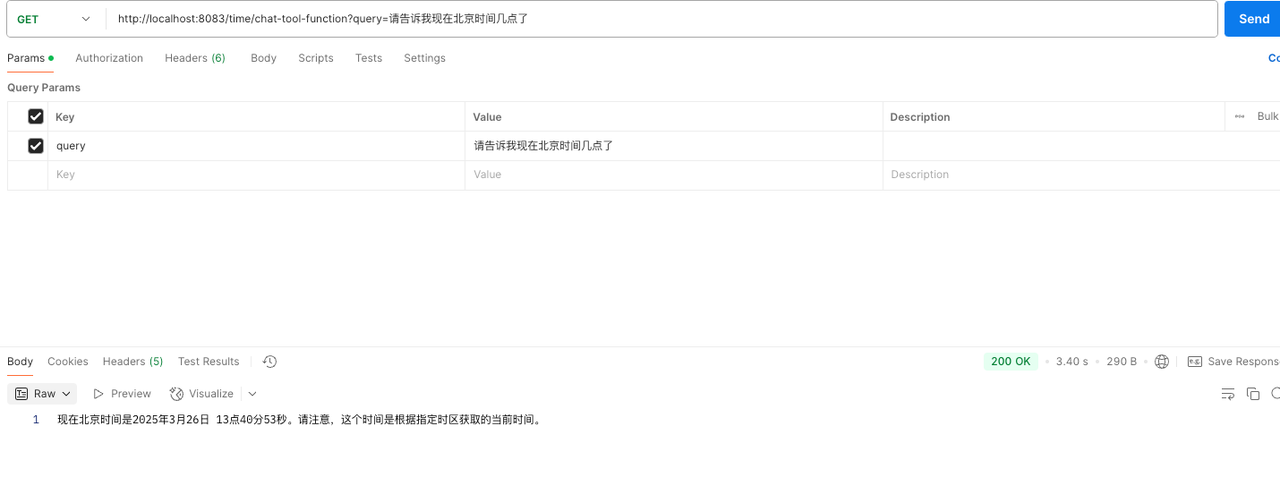
工具版 - method
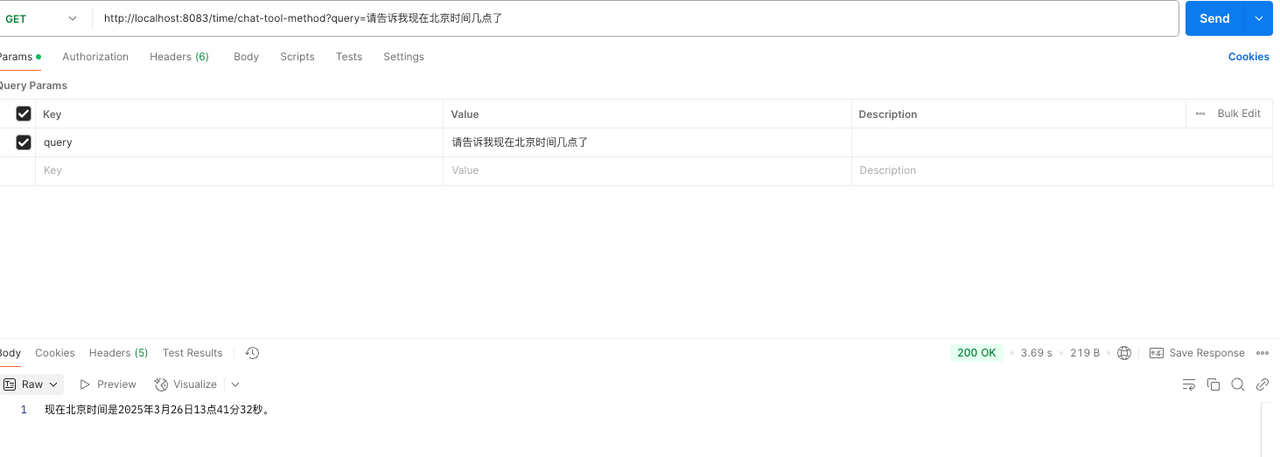
天气预测
WeatherAutoConfiguration
import org.springframework.boot.autoconfigure.condition.ConditionalOnClass;import org.springframework.boot.autoconfigure.condition.ConditionalOnMissingBean;import org.springframework.boot.autoconfigure.condition.ConditionalOnProperty;import org.springframework.boot.context.properties.EnableConfigurationProperties;import org.springframework.context.annotation.Bean;import org.springframework.context.annotation.Configuration;import org.springframework.context.annotation.Description;
@Configuration@ConditionalOnClass(WeatherService.class)@EnableConfigurationProperties(WeatherProperties.class)@ConditionalOnProperty(prefix = "spring.ai.toolcalling.weather", name = "enabled", havingValue = "true")public class WeatherAutoConfiguration {
@Bean(name = "getWeatherFunction") @ConditionalOnMissingBean @Description("Use api.weather to get weather information.") public WeatherService getWeatherServiceFunction(WeatherProperties properties) { return new WeatherService(properties); }
}@Configuration:定义为配置类@ConditionalOnClass({WeatherService.class}):只有当类路径中存在WeatherService类才会加载该配置类@ConditionalOnProperty(prefix = "spring.ai.toolcalling.weather", name = "enabled", havingValue = "true"):只有当配置文件处spring.ai.toolcalling.weather.enabled值为true时才会加载该配置类@Bean(name = "getWeatherFunction"):定义该Bean名称为getWeatherFunction,并注册到Spring容器中@ConditionalOnMissingBean:只有当Spring容器中不存在GetCurrentTimeByTimeZoneIdService类型的Bean时,才会创建该Bean@EnableConfigurationProperties(WeatherProperties.class):启用对WeatherProperties类的配置属性支持
WeatherProperties
@ConfigurationProperties(prefix = "spring.ai.toolcalling.weather")public class WeatherProperties {
private String apiKey;
public String getApiKey() { return apiKey; }
public void setApiKey(String apiKey) { this.apiKey = apiKey; }
}从配置文件中获取apiKey
WeatherService
import cn.hutool.extra.pinyin.PinyinUtil;import com.fasterxml.jackson.annotation.JsonClassDescription;import com.fasterxml.jackson.annotation.JsonInclude;import com.fasterxml.jackson.annotation.JsonProperty;import com.fasterxml.jackson.annotation.JsonPropertyDescription;import com.fasterxml.jackson.core.type.TypeReference;import com.fasterxml.jackson.databind.ObjectMapper;import org.slf4j.Logger;import org.slf4j.LoggerFactory;import org.springframework.http.HttpHeaders;import org.springframework.util.StringUtils;import org.springframework.web.reactive.function.client.WebClient;import org.springframework.web.util.UriComponentsBuilder;import reactor.core.publisher.Mono;
import java.util.List;import java.util.Map;import java.util.function.Function;
public class WeatherService implements Function<WeatherService.Request, WeatherService.Response> {
private static final Logger logger = LoggerFactory.getLogger(WeatherService.class);
private static final String WEATHER_API_URL = "https://api.weatherapi.com/v1/forecast.json";
private final WebClient webClient;
private final ObjectMapper objectMapper = new ObjectMapper();
public WeatherService(WeatherProperties properties) { this.webClient = WebClient.builder() .defaultHeader(HttpHeaders.CONTENT_TYPE, "application/x-www-form-urlencoded") .defaultHeader("key", properties.getApiKey()) .build(); }
public static Response fromJson(Map<String, Object> json) { Map<String, Object> location = (Map<String, Object>) json.get("location"); Map<String, Object> current = (Map<String, Object>) json.get("current"); Map<String, Object> forecast = (Map<String, Object>) json.get("forecast"); List<Map<String, Object>> forecastDays = (List<Map<String, Object>>) forecast.get("forecastday"); String city = (String) location.get("name"); return new Response(city, current, forecastDays); }
@Override public Response apply(Request request) { if (request == null || !StringUtils.hasText(request.city())) { logger.error("Invalid request: city is required."); return null; } String location = preprocessLocation(request.city()); String url = UriComponentsBuilder.fromHttpUrl(WEATHER_API_URL) .queryParam("q", location) .queryParam("days", request.days()) .toUriString(); try { Mono<String> responseMono = webClient.get().uri(url).retrieve().bodyToMono(String.class); String jsonResponse = responseMono.block(); assert jsonResponse != null;
Response response = fromJson(objectMapper.readValue(jsonResponse, new TypeReference<Map<String, Object>>() { })); logger.info("Weather data fetched successfully for city: {}", response.city()); return response; } catch (Exception e) { logger.error("Failed to fetch weather data: {}", e.getMessage()); return null; } }
// Use the tools in hutool to convert Chinese place names into pinyin private String preprocessLocation(String location) { if (containsChinese(location)) { return PinyinUtil.getPinyin(location, ""); } return location; }
private boolean containsChinese(String str) { return str.matches(".*[\u4e00-\u9fa5].*"); }
@JsonInclude(JsonInclude.Include.NON_NULL) @JsonClassDescription("Weather Service API request") public record Request( @JsonProperty(required = true, value = "city") @JsonPropertyDescription("city name") String city,
@JsonProperty(required = true, value = "days") @JsonPropertyDescription("Number of days of weather forecast. Value ranges from 1 to 14") int days) { }
@JsonClassDescription("Weather Service API response") public record Response( @JsonProperty(required = true, value = "city") @JsonPropertyDescription("city name") String city, @JsonProperty(required = true, value = "current") @JsonPropertyDescription("Current weather info") Map<String, Object> current, @JsonProperty(required = true, value = "forecastDays") @JsonPropertyDescription("Forecast weather info") List<Map<String, Object>> forecastDays) { }
}- 实现Function接口,重写apply方法,确保输入为Request、输出为Response
- Request类为记录类,需要添加方法描述(JsonClassDescription) + 参数描述(JsonProperty),主要用于让模型提取出对应的输入参数city、days
- 先尝试调通所用API接口,查看数据格式,根据需要取对应的返回数据(这里可以不用全取,token太多模型返回有点慢)
WeatherTools(单独实现MethodToolCallback版)
import com.fasterxml.jackson.core.type.TypeReference;import com.fasterxml.jackson.databind.ObjectMapper;import org.slf4j.Logger;import org.slf4j.LoggerFactory;import org.springframework.ai.tool.annotation.Tool;import org.springframework.ai.tool.annotation.ToolParam;import org.springframework.http.HttpHeaders;import org.springframework.util.StringUtils;import org.springframework.web.reactive.function.client.WebClient;import org.springframework.web.util.UriComponentsBuilder;import reactor.core.publisher.Mono;
import java.util.List;import java.util.Map;
public class WeatherTools {
private static final Logger logger = LoggerFactory.getLogger(WeatherTools.class);
private static final String WEATHER_API_URL = "https://api.weatherapi.com/v1/forecast.json";
private final WebClient webClient;
private final ObjectMapper objectMapper = new ObjectMapper();
public WeatherTools(WeatherProperties properties) { this.webClient = WebClient.builder() .defaultHeader(HttpHeaders.CONTENT_TYPE, "application/x-www-form-urlencoded") .defaultHeader("key", properties.getApiKey()) .build(); }
@Tool(description = "Use api.weather to get weather information.") public Response getWeatherServiceMethod(@ToolParam(description = "City name") String city, @ToolParam(description = "Number of days of weather forecast. Value ranges from 1 to 14") int days) {
if (!StringUtils.hasText(city)) { logger.error("Invalid request: city is required."); return null; } String location = WeatherUtils.preprocessLocation(city); String url = UriComponentsBuilder.fromHttpUrl(WEATHER_API_URL) .queryParam("q", location) .queryParam("days", days) .toUriString(); logger.info("url : {}", url); try { Mono<String> responseMono = webClient.get().uri(url).retrieve().bodyToMono(String.class); String jsonResponse = responseMono.block(); assert jsonResponse != null;
Response response = fromJson(objectMapper.readValue(jsonResponse, new TypeReference<Map<String, Object>>() { })); logger.info("Weather data fetched successfully for city: {}", response.city()); return response; } catch (Exception e) { logger.error("Failed to fetch weather data: {}", e.getMessage()); return null; } }
public static Response fromJson(Map<String, Object> json) { Map<String, Object> location = (Map<String, Object>) json.get("location"); Map<String, Object> current = (Map<String, Object>) json.get("current"); Map<String, Object> forecast = (Map<String, Object>) json.get("forecast"); List<Map<String, Object>> forecastDays = (List<Map<String, Object>>) forecast.get("forecastday"); String city = (String) location.get("name"); return new Response(city, current, forecastDays); }
public record Response(String city, Map<String, Object> current, List<Map<String, Object>> forecastDays) { }
}WeatherController
import com.yingzi.toolCalling.component.weather.WeatherProperties;import com.yingzi.toolCalling.component.weather.WeatherTools;import org.springframework.ai.chat.client.ChatClient;import org.springframework.web.bind.annotation.GetMapping;import org.springframework.web.bind.annotation.RequestMapping;import org.springframework.web.bind.annotation.RequestParam;import org.springframework.web.bind.annotation.RestController;
@RestController@RequestMapping("/weather")public class WeatherController {
private final ChatClient dashScopeChatClient;
private final WeatherProperties weatherProperties;
public WeatherController(ChatClient.Builder chatClientBuilder, WeatherProperties weatherProperties) { this.dashScopeChatClient = chatClientBuilder.build(); this.weatherProperties = weatherProperties; }
/** * 无工具版 */ @GetMapping("/chat") public String simpleChat(@RequestParam(value = "query", defaultValue = "请告诉我北京1天以后的天气") String query) { return dashScopeChatClient.prompt(query).call().content(); }
/** * 调用工具版 - function */ @GetMapping("/chat-tool-function") public String chatTranslateFunction(@RequestParam(value = "query", defaultValue = "请告诉我北京1天以后的天气") String query) { return dashScopeChatClient.prompt(query).tools("getWeatherFunction").call().content(); }
/** * 调用工具版 - method */ @GetMapping("/chat-tool-method") public String chatTranslateMethod(@RequestParam(value = "query", defaultValue = "请告诉我北京1天以后的天气") String query) { return dashScopeChatClient.prompt(query).tools(new WeatherTools(weatherProperties)).call().content(); }}效果展示
无工具版
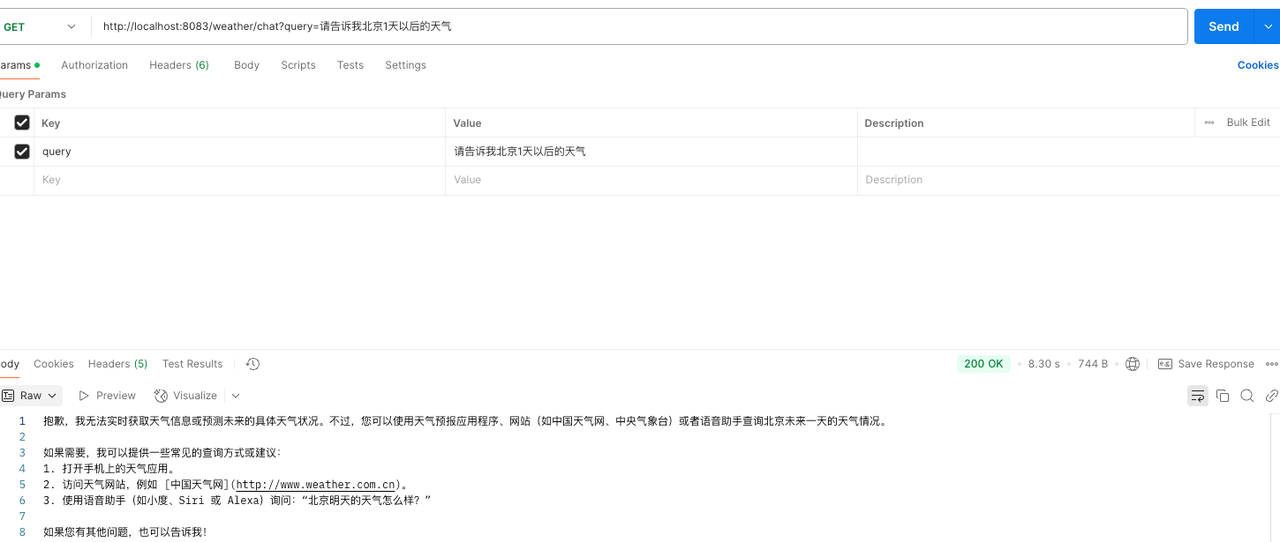
工具版 - function

工具版 - method

百度翻译
BaidutranslateAutoConfiguration
import org.springframework.boot.autoconfigure.condition.ConditionalOnClass;import org.springframework.boot.autoconfigure.condition.ConditionalOnMissingBean;import org.springframework.boot.autoconfigure.condition.ConditionalOnProperty;import org.springframework.boot.context.properties.EnableConfigurationProperties;import org.springframework.context.annotation.Bean;import org.springframework.context.annotation.Configuration;import org.springframework.context.annotation.Description;
@Configuration@ConditionalOnClass(BaidutranslateService.class)@EnableConfigurationProperties(BaidutranslateProperties.class)@ConditionalOnProperty(prefix = "spring.ai.toolcalling.baidutranslate", name = "enabled", havingValue = "true")public class BaidutranslateAutoConfiguration {
@Bean(name = "baiduTranslateFunction") @ConditionalOnMissingBean @Description("Baidu translation function for general text translation") public BaidutranslateService baiduTranslateFunction(BaidutranslateProperties properties) { return new BaidutranslateService(properties); }
}同上
BaidutranslateProperties
import org.springframework.boot.context.properties.ConfigurationProperties;
@ConfigurationProperties(prefix = "spring.ai.toolcalling.baidutranslate")public class BaidutranslateProperties {
private String appId;
private String secretKey;
public String getSecretKey() { return secretKey; }
public void setSecretKey(String secretKey) { this.secretKey = secretKey; }
public String getAppId() { return appId; }
public void setAppId(String appId) { this.appId = appId; }
}同上
BaidutranslateService
import com.fasterxml.jackson.annotation.JsonClassDescription;import com.fasterxml.jackson.annotation.JsonProperty;import com.fasterxml.jackson.annotation.JsonPropertyDescription;import com.fasterxml.jackson.databind.ObjectMapper;import org.slf4j.Logger;import org.slf4j.LoggerFactory;import org.springframework.http.HttpHeaders;import org.springframework.util.DigestUtils;import org.springframework.util.LinkedMultiValueMap;import org.springframework.util.MultiValueMap;import org.springframework.util.StringUtils;import org.springframework.web.reactive.function.client.WebClient;import org.springframework.web.util.UriComponentsBuilder;import reactor.core.publisher.Mono;
import java.util.HashMap;import java.util.List;import java.util.Map;import java.util.Random;import java.util.function.Function;
public class BaidutranslateService implements Function<BaidutranslateService.Request, BaidutranslateService.Response> {
private static final Logger logger = LoggerFactory.getLogger(BaidutranslateService.class);
private static final String TRANSLATE_HOST_URL = "https://fanyi-api.baidu.com/api/trans/vip/translate";
private static final Random random = new Random();
private final String appId;
private final String secretKey;
private final WebClient webClient;
public BaidutranslateService(BaidutranslateProperties properties) { assert StringUtils.hasText(properties.getAppId()); this.appId = properties.getAppId(); assert StringUtils.hasText(properties.getSecretKey()); this.secretKey = properties.getSecretKey();
this.webClient = WebClient.builder() .defaultHeader(HttpHeaders.CONTENT_TYPE, "application/x-www-form-urlencoded") .build(); }
@Override public Response apply(Request request) { if (request == null || !StringUtils.hasText(request.q) || !StringUtils.hasText(request.from) || !StringUtils.hasText(request.to)) { return null; } String salt = String.valueOf(random.nextInt(100000)); String sign = DigestUtils.md5DigestAsHex((appId + request.q + salt + secretKey).getBytes()); String url = UriComponentsBuilder.fromHttpUrl(TRANSLATE_HOST_URL).toUriString(); try { MultiValueMap<String, String> body = constructRequestBody(request, salt, sign); Mono<String> responseMono = webClient.post().uri(url).bodyValue(body).retrieve().bodyToMono(String.class);
String responseData = responseMono.block(); assert responseData != null; logger.info("Translation request: {}, response: {}", request.q, responseData);
return parseResponse(responseData);
} catch (Exception e) { logger.error("Failed to invoke translate API due to: {}", e.getMessage()); return null; } }
private MultiValueMap<String, String> constructRequestBody(Request request, String salt, String sign) { MultiValueMap<String, String> body = new LinkedMultiValueMap<>(); body.add("q", request.q); body.add("from", request.from); body.add("to", request.to); body.add("appid", appId); body.add("salt", salt); body.add("sign", sign); return body; }
private Response parseResponse(String responseData) { ObjectMapper mapper = new ObjectMapper(); try { Map<String, String> translations = new HashMap<>(); TranslationResponse responseList = mapper.readValue(responseData, TranslationResponse.class); String to = responseList.to; List<TranslationResult> translationsList = responseList.trans_result; if (translationsList != null) { for (TranslationResult translation : translationsList) { String translatedText = translation.dst; translations.put(to, translatedText); logger.info("Translated text to {}: {}", to, translatedText); } } return new Response(translations); } catch (Exception e) { try { Map<String, String> responseList = mapper.readValue(responseData, mapper.getTypeFactory().constructMapType(Map.class, String.class, String.class)); logger.info( "Translation exception, please inquire Baidu translation api documentation to info error_code:{}", responseList); return new Response(responseList); } catch (Exception ex) { logger.error("Failed to parse json due to: {}", ex.getMessage()); return null; } } }
@JsonClassDescription("Request to translate text to a target language") public record Request( @JsonProperty(required = true, value = "q") @JsonPropertyDescription("Content that needs to be translated") String q, @JsonProperty(required = true, value = "from") @JsonPropertyDescription("Source language that needs to be translated") String from, @JsonProperty(required = true, value = "to") @JsonPropertyDescription("Target language to translate into") String to) { }
@JsonClassDescription("Response to translate text to a target language") public record Response(Map<String, String> translatedTexts) { }
@JsonClassDescription("part of the response") public record TranslationResult( @JsonProperty(required = true, value = "src") @JsonPropertyDescription("Original Content") String src, @JsonProperty(required = true, value = "dst") @JsonPropertyDescription("Final Result") String dst) { }
@JsonClassDescription("complete response") public record TranslationResponse( @JsonProperty(required = true, value = "from") @JsonPropertyDescription("Source language that needs to be translated") String from, @JsonProperty(required = true, value = "to") @JsonPropertyDescription("Target language to translate into") String to, @JsonProperty(required = true, value = "trans_result") @JsonPropertyDescription("part of the response") List<TranslationResult> trans_result) { }
}- Request中指定三个参数
- q:什么内容需要被翻译
- from:源内容需要什么语言
- to:目标内容为什么语言
- 这里对翻译API返回的字段类型做了更加详细的描述
BaidutranslateTools(单独实现MethodToolCallback版)
import com.fasterxml.jackson.databind.ObjectMapper;import org.slf4j.Logger;import org.slf4j.LoggerFactory;import org.springframework.ai.tool.annotation.Tool;import org.springframework.ai.tool.annotation.ToolParam;import org.springframework.http.HttpHeaders;import org.springframework.util.DigestUtils;import org.springframework.util.LinkedMultiValueMap;import org.springframework.util.MultiValueMap;import org.springframework.util.StringUtils;import org.springframework.web.reactive.function.client.WebClient;import org.springframework.web.util.UriComponentsBuilder;import reactor.core.publisher.Mono;
import java.util.HashMap;import java.util.List;import java.util.Map;import java.util.Random;
public class BaidutranslateTools {
private static final Logger logger = LoggerFactory.getLogger(BaidutranslateTools.class);
private static final String TRANSLATE_HOST_URL = "https://fanyi-api.baidu.com/api/trans/vip/translate";
private static final Random random = new Random(); private final WebClient webClient; private final String appId; private final String secretKey;
public BaidutranslateTools(BaidutranslateProperties properties) { assert StringUtils.hasText(properties.getAppId()); this.appId = properties.getAppId(); assert StringUtils.hasText(properties.getSecretKey()); this.secretKey = properties.getSecretKey();
this.webClient = WebClient.builder() .defaultHeader(HttpHeaders.CONTENT_TYPE, "application/x-www-form-urlencoded") .build(); }
@Tool(description = "Baidu translation function for general text translation") public Map<String, String> baiduTranslateMethod(@ToolParam(description = "Content that needs to be translated") String q, @ToolParam(description = "Source language that needs to be translated") String from, @ToolParam(description = "Target language to translate into") String to) { if (!StringUtils.hasText(q) || !StringUtils.hasText(from) || !StringUtils.hasText(to)) { return null; } String salt = String.valueOf(random.nextInt(100000)); String sign = DigestUtils.md5DigestAsHex((appId + q + salt + secretKey).getBytes()); String url = UriComponentsBuilder.fromHttpUrl(TRANSLATE_HOST_URL).toUriString(); try { MultiValueMap<String, String> body = constructRequestBody(q, from, to, salt, sign); Mono<String> responseMono = webClient.post().uri(url).bodyValue(body).retrieve().bodyToMono(String.class);
String responseData = responseMono.block(); assert responseData != null; logger.info("Translation request: {}, response: {}", q, responseData);
return parseResponse(responseData);
} catch (Exception e) { logger.error("Failed to invoke translate API due to: {}", e.getMessage()); return null; } }
private MultiValueMap<String, String> constructRequestBody(String q, String from, String to, String salt, String sign) { MultiValueMap<String, String> body = new LinkedMultiValueMap<>(); body.add("q", q); body.add("from", from); body.add("to", to); body.add("appid", appId); body.add("salt", salt); body.add("sign", sign); return body; }
private Map<String, String> parseResponse(String responseData) { ObjectMapper mapper = new ObjectMapper(); try { Map<String, String> translations = new HashMap<>(); TranslationResponse responseList = mapper.readValue(responseData, TranslationResponse.class); String to = responseList.to; List<TranslationResult> translationsList = responseList.trans_result; if (translationsList != null) { for (TranslationResult translation : translationsList) { String translatedText = translation.dst; translations.put(to, translatedText); logger.info("Translated text to {}: {}", to, translatedText); } } return translations; } catch (Exception e) { try { Map<String, String> responseList = mapper.readValue(responseData, mapper.getTypeFactory().constructMapType(Map.class, String.class, String.class)); logger.info( "Translation exception, please inquire Baidu translation api documentation to info error_code:{}", responseList); return responseList; } catch (Exception ex) { logger.error("Failed to parse json due to: {}", ex.getMessage()); return null; } } }
public record TranslationResult(String src, String dst) { }
public record TranslationResponse(String from, String to, List<TranslationResult> trans_result) { }}TranslateController
import com.yingzi.toolCalling.component.baidutranslate.BaidutranslateProperties;import com.yingzi.toolCalling.component.baidutranslate.BaidutranslateTools;import org.springframework.ai.chat.client.ChatClient;import org.springframework.web.bind.annotation.GetMapping;import org.springframework.web.bind.annotation.RequestMapping;import org.springframework.web.bind.annotation.RequestParam;import org.springframework.web.bind.annotation.RestController;
@RestController@RequestMapping("/translate")public class TranslateController {
private final ChatClient dashScopeChatClient; private final BaidutranslateProperties baidutranslateProperties;
public TranslateController(ChatClient.Builder chatClientBuilder, BaidutranslateProperties baidutranslateProperties) { this.dashScopeChatClient = chatClientBuilder.build(); this.baidutranslateProperties = baidutranslateProperties; }
/** * 无工具版 */ @GetMapping("/chat") public String simpleChat(@RequestParam(value = "query", defaultValue = "帮我把以下内容翻译成英文:你好,世界。") String query) { return dashScopeChatClient.prompt(query).call().content(); }
/** * 调用工具版 - function */ @GetMapping("/chat-tool-function") public String chatTranslateFunction(@RequestParam(value = "query", defaultValue = "帮我把以下内容翻译成英文:你好,世界。") String query) { return dashScopeChatClient.prompt(query).tools("baiduTranslateFunction").call().content(); }
/** * 调用工具版 - method */ @GetMapping("/chat-tool-method") public String chatTranslateMethod(@RequestParam(value = "query", defaultValue = "帮我把以下内容翻译成英文:你好,世界。") String query) { // 从配置文件中,获取,自动加载 return dashScopeChatClient.prompt(query).tools(new BaidutranslateTools(baidutranslateProperties)).call().content(); }
}效果展示
无工具版
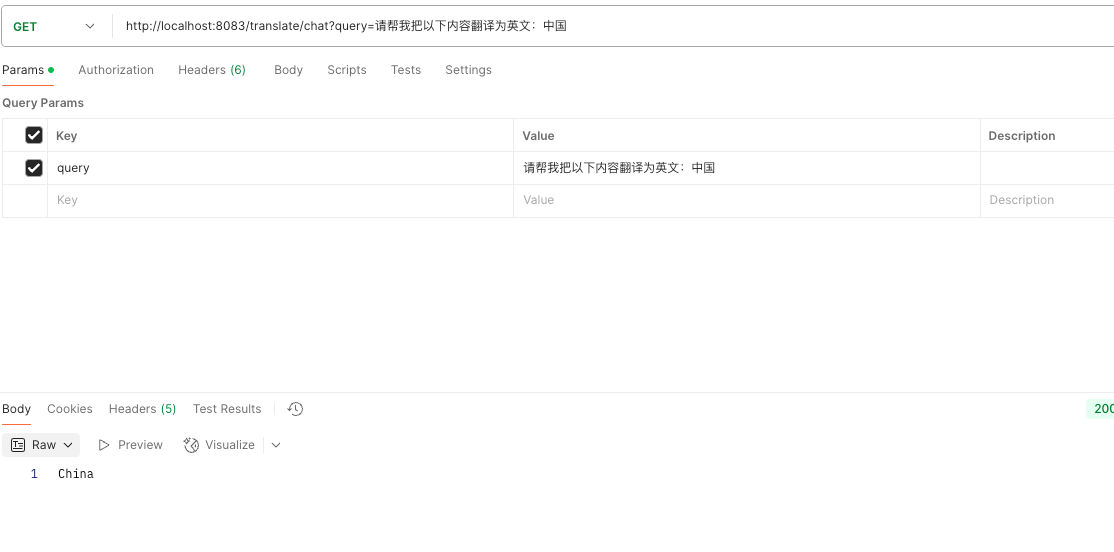
工具版 - function

工具版 - method

参考资料
https://docs.spring.io/spring-ai/reference/api/tools.html#_quick_start
https://docs.spring.io/spring-ai/reference/api/tools-migration.html
Spring AI 框架在升级,Function Calling 废弃,被 Tool Calling 取代
https://mp.weixin.qq.com/s/kcQ1lifA8oH2ee16QxDYYg
Spring-ai-alibaba项目下tool工具模块
- spring-ai-alibaba-starter-tool-calling-time
- spring-ai-alibaba-starter-tool-calling-weather
- spring-ai-alibaba-starter-tool-calling-baidutranslate


